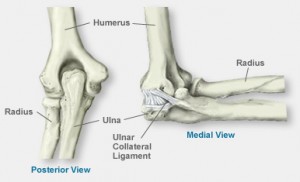To understand how an elbow can get dislocated, it will help if you learn a little about the anatomy of the elbow.
Your elbow joint consists of three different bones namely the:
This is the long, large bone located in your upper arm. There are two prominent regions of the humerous that are located inside and outside the elbow known as epicondyles. The lateral epicondyle is attached to the muscles that elevate the hand and wrist whereas; the muscles that allow the wrist to flex are attached to the medical epicondyle.
- Radius
This is one of the two long bones located in the forearm.
- Ulna
Like the radius, the ulna is also located in the forearm.
The three bones, humerous, radius and ulna are connected the together with strong tissues or bands called the ligaments. The muscles, tendons and ligaments facilitate the movements of the bones and keep them in place while making movement.
What is a dislocated elbow?
A dislocated elbow refers to a condition in which a bone in the elbow is displaced, that is it has come out of its original place. The elbow joint is made of three distinct bones, the humerous, radius and ulna.
In many people, elbow dislocation occurs along with elbow fractures. Most cases of elbow dislocations occur in children and the condition is called ‘nursemaid’s elbow’ in which the radius (located in the forearm along with the ulna) is displaced in the elbow joint.
Disclaimer: the material posted on this page is for information purposes only. To learn to help individuals with dislocated elbows and other skeletal emergencies enrol in St Mark James first aid training.
Signs and symptoms of elbow dislocation
Common signs and symptoms of elbow dislocation include:
- Severe pain in the elbow
- Pain that worsens while making movement
- Swelling of the elbow
- Deformity of the elbow
- Bruising of the skin around the elbow region
- Inability to move the affected elbow joint
- Weakness of the hand – unilateral
- Numbness of the hand – unilateral
It is important to note that an elbow dislocation is an emergency situation therefore, if your suspect an elbow dislocation through any of the symptoms above, seek emergency medical help immediately. If you see someone who is suffering from an elbow fracture due to a car accident, sport accident, fall or physical assault because of an altercation, call 911 immediately or take him to the nearest hospital. Prompt treatment is essential for quick recovery; therefore, treatment should not be delayed under any circumstance.
The doctor would most probably restore the alignment of the elbow joint bones. This often does require surgery.
Treatment
1. Do not move the elbow joint or the arm
- Trying to move the elbow joint or trying to align the bones yourself may exacerbate the condition and cause more damage. Therefore, do NOT try to repair the damage yourself!
2. Treat the symptoms of the damage
- For swelling and pain, applying an ice pack or ice wrapped in a towel will help while you wait for medical assistance
- Take over-the-counter pain killers such as ibuprofen or acetaminophen to alleviate pain. Avoid NSAIDs in case you are bleeding severely. Do not give aspirin to children and teenagers under 18 years of age
At the hospital, your health care provider will evaluate the condition of the arm and check for any internal damages associated with the nerves and arteries. An X-Ray shall be taken to check for dislocations or fractures.
Simple dislocations can be recovered with pain medication and sedation medication in the emergency room. Surgery may be required in some cases.
Learn More
To learn more about skeletal emergencies and dislocated elbows enrol in a St Mark James first aid program (sign up here). Courses such as standard first aid are ideal for learning with “hands on” training on how to be prepared for these types of injuries.

